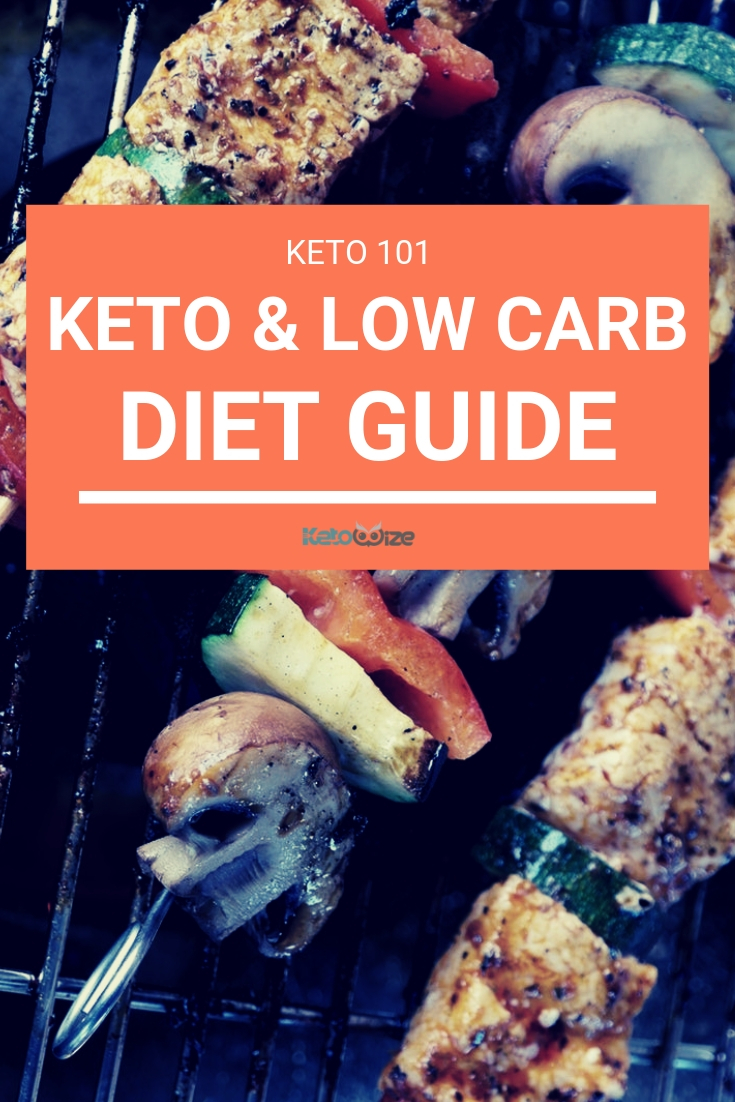New To Keto & Low-Carb? Keto 101: The Basics of the Low Carb Lifestyle
If you’re ready to kick your keto diet into high gear and start burning fat for fuel, you’re definitely in the right place. Our KETO 101 guide has everything you need to start your low-carb diet.
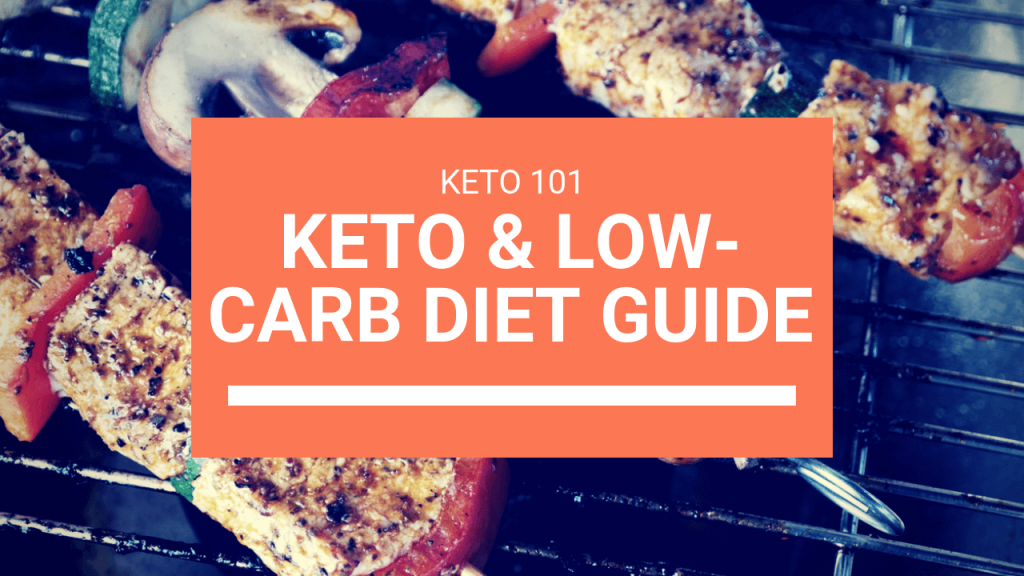
Share This Guide
It’s at once one of the oldest diet plans out there, and at the same time, the hottest thing going – The Ketogenic Diet.
While it’s gone under many different names throughout recent history – banting, Atkins, Protein Power, low carb – the lifestyle is the same, keeping carbohydrates and sugars to a minimum while eating a moderate amount of protein and high amount of fat.
If you’re trying to lose weight or just get healthier, you’ve probably already looked into this diet, but the information overload is intense, ranging from “OMG…this is the best thing ever!” to “eating all that fat will kill you.”
In this guide we’re going to give you an overview of what the keto diet entails, how it works, what it does, and – most importantly -what you can eat.
What Is The Keto Diet?
The keto diet is a diet low in carbohydrates, moderate in protein, and high in fat. Eating this low carb high fat (LCHF) diet encourages your body to use fat as its energy source, resulting not only in weight loss, but a steadier flow of energy without the stark highs and lows of a glucose-heavy diet.
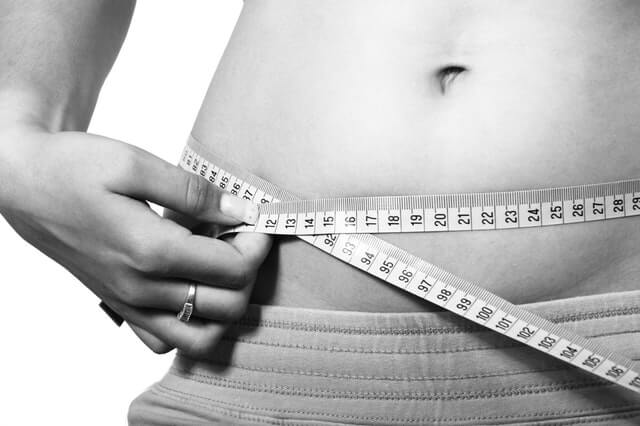
Usually within 3 days to 1 week of eating a keto diet, your body adapts and begins using ketones from fat (instead of glucose from carbs) as its primary source of fuel. This metabolic process is known as ketosis. Once you enter the state of ketosis, you not only use the fat from your food as fuel, but also your stored body fat too. This is one of the main draws of the keto diet – eating delicious fatty foods while loosing weight because your body has adapted to become a “fat-burning furnace!”
Types of Ketogenic Diets
There are several types of ketogenic diets that have gained popularity in recent years, and while they share a lot of similarities, there are definitely some key differences that should be noted.
The Standard Ketogenic Diet (SKD) is definitely the most popular keto diet variation and pretty much what we have described above. It’s the main focus of the Ketowize website and is the version most people follow. On a Standard Ketogenic Diet you generally consume 70% of your calories from fat, 25% of your calories from protein, and 5% of your calories from carbohydrates.
The Cyclical Ketogenic Diet (CKD) is very popular among bodybuilders who are looking to get down to extremely low body fat levels for competitions and shows. The cyclical ketogenic diet inserts a day of “carb loading” (usually once a week) to replenish muscle glycogen and improve energy.
The Targeted Ketogenic Diet (TKD) is more similar to the SKD and is popular among athletes who require extra energy to make it through intense workouts. With the TKD, the individual targets their carb consumption around their workouts to meet their energy needs.
The High Protein Ketogenic Diet calls for upping your protein intake just a bit. In this variation, protein should make up 30-35% of calories, while fat calories account for 60-70%. Carb calories are further reduced to under 5%. Since excess consumed protein converts to glucose, the High Protein Ketogenic Diet has you “carb loading” through extra protein rather than carb-heavy foods.
Is The Keto Diet Safe?
If you’ve done much Internet research on the keto diet, you’ve probably come across a few articles which claim that it’s dangerous or unhealthy.
“Overeating fat will clog your arteries!” they cry.
“You won’t get enough nutrients!”
“All that protein will destroy your kidneys!”
“You need to eat grains and sugars!”
“Being in ketosis too long can be fatal!”
The belief that consuming fats is unhealthy comes primarily from two studies, the Framingham Study and the Seven Country Study.

The Framingham Study, which began in 1948, is a multigenerational study of residents of Framingham, Massachusetts that is still ongoing. The Seven Country Study, which took place between 1952 to 1957, was instigated by Dr. Ancel Keys, an American physiologist who had done numerous other studies on how diet affected overall health and concentrated this study in seven non-North American nations to observe the rates of heart disease in these populations.
Both studies noted that there was a higher incidence of heart disease among those who consumed more animal fat but overlooked other factors such as tobacco and alcohol use.
Fat consumption is correlated with heart disease, but to date, it hasn’t been significantly proven to cause heart disease. In recent years, the demonization of fat has lessened considerably, although some fats are considered better than others.
The supposed lack of nutrients on the ketogenic diet is another bone of contention. Many claim that avoiding grains, starches, most fruits, and non-green vegetables will lead to malnutrition and believe that keto dieters eat nothing but steak, bacon, and cheese. However, many keto dieters find that they’re actually eating more vegetables than they had previously, and increasing meat consumption means not only getting more complete proteins, but also vital amino acids and nutrients such as vitamin B12, zinc, and potassium among others.
While there’s truth that excess protein consumption can interfere with kidney function, this happens with already damaged kidneys. As we noted before, excess protein converts to glucose, the fuel the body will use first, which is why the standard ketogenic diet encourages higher consumption of fat rather than protein. If your kidney function is fine, going ketogenic won’t adversely affect it.
Benefits of Going Ketogenic
While the primary reason people undertake a ketogenic diet is for weight loss, there are a lot of other benefits that come when following this way of eating.
Reduced Hunger + Increased Energy
Since you’re eating primarily fat and some protein, both of which are naturally satisfying, you’ll find that your hunger is significantly reduced. This is because fat is a more constant burning and reliable energy source. And, since fat is much more satiating than fast-burning carbohydrates, you’ll find yourself feeling full and satisfied for much longer while on a keto diet.
Improved Mental Clarity

By their very nature, carbohydrates burn fast, meaning you experience extreme spikes in blood sugar. These spikes lead to an eventual crash which often put you in a mental brain fog. Soon you’re reaching for a coffee, energy drink, or candy bar just to get back to baseline.
When you begin using ketones as fuel, you will quickly notice an improvement in mental performance, clarity, focus, concentration, and even problem-solving abilities.
Accelerated Weight Loss
Chances are, this is why you’re here, right? Switching your body’s main fuel source from glucose to ketones means you’ll quickly be burning body fat for energy, resulting in rapid and sustained weight loss.
This is not just a matter of opinion or speculation. Scientific studies have proven over and over again that a low-carb ketogenic diet yields significantly better results than the traditional low-fat diet popularized in decades past.
Control Blood Sugar
Since you’re cutting out high-sugar and high-carbohydrate foods (which convert to sugar in the bloodstream), many people notice lower blood sugar levels on a ketogenic diet.
In fact, many doctors recommend a low-carbohydrate keto diet to Type 2 Diabetics to restore normal blood sugar functions, and the ketogenic diet has been shown to restore blood sugar patterns in diabetics since one is essentially eliminating the foods that cause blood sugar imbalances.
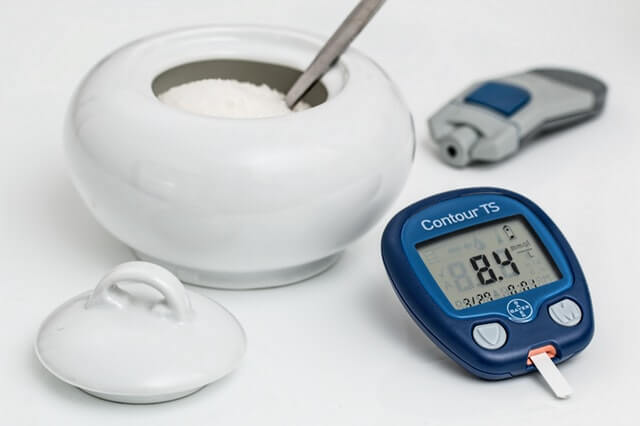
Higher Good Cholesterol
Reduced Risk of Many Types of Cancer
Cancer is a debilitating disease, touching nearly every family in the United States and throughout the world. Cutting carbs and processed foods (which are inherently carb heavy), when combined with other types of treatment, has been shown to increase survival rates in some types of cancers.
Digestive Support
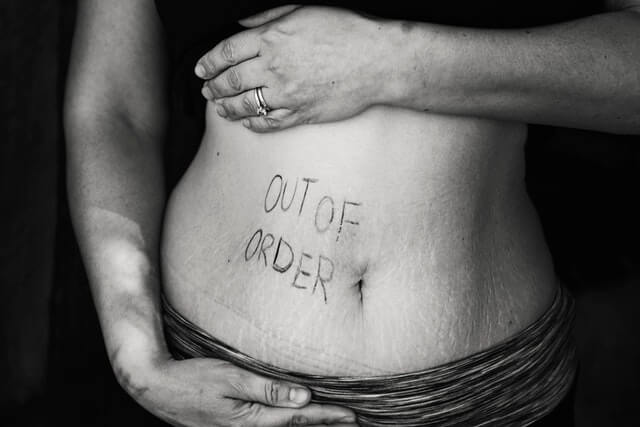
Eliminating or significantly reducing carbs can make a huge difference for those who suffer ongoing digestive issues. Many starches, sugars, and grains have been linked to bloating, GERD, and constipation in a host of individuals.
Furthermore, it has been reported that fat actually feeds good gut bacteria, promoting healthier digestion and stomach health.
Improve Cardiovascular Health
While it may contradict conventional wisdom, eating a high fat ketogenic diet has been shown in studies to improve cardiovascular health. This flies in the face of the “heart healthy grains” argument that has been perpetuated for decades by the food lobby in the United States. Studies have begun to show that patients following a low carb diet (vs. a low fat diet) have lower cholesterol, lower triglyceride levels, and an improvement in overall cardiovascular health.
What Is Ketosis
All food fuels your body, but different foods fuel your body in different ways.
For many of us, a typical breakfast is a sweetened coffee and a fast food breakfast sandwich or pastry. This meal has lots of carbohydrates and sugars, which once consumed convert to the simplest sugar, glucose.
Your body will use glucose before any other fuel to power itself. This is the reason you’ll feel a burst of energy after eating this type of meal.
Glucose has a helper hormone called insulin, which takes glucose around the body for maximum power. However, glucose burns fast and hot, which is why you’ll feel “the crash”–and the need for another coffee and pastry or candy bar a few hours after eating.
When your body can’t find glucose, it makes ketones, an energy source derived from fat, and feeds off that. When your ketone levels are elevated, this is known as ketosis, and once you get into ketosis, you’ll start seeing the benefits we’ve listed above.
How to Reach Ketosis
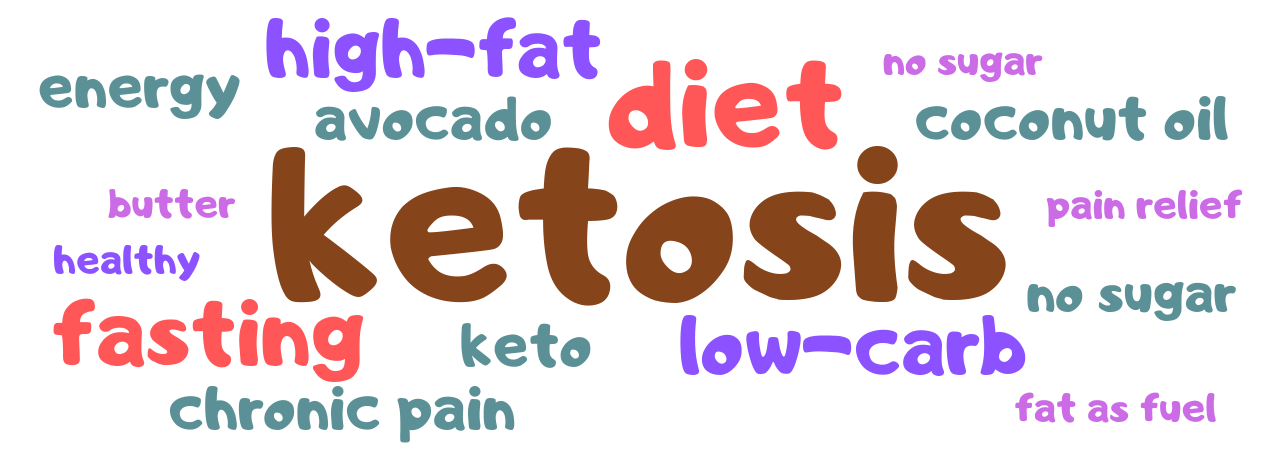
The easiest way to get your ketone levels up is to limit your carbohydrates while increasing your protein and fat consumption. Ideally, a ketogenic diet should consist of 60 to 80 percent fat, 20 to 30 percent protein, and only 5 to 10 percent carbs.
Compare this to the standard American diet, which suggests 300 grams of carbs a day!
A diet that goes below 100 daily carbs is considered low carb, but a ketogenic meal plan will go much lower than that, usually around 20 to 50 carbs per day.
Testing for Ketosis
There are a several ways to check your ketone levels.
Ketone test strips are popular because they’re simple to use. You simply swipe one through your urine stream and wait a few seconds. The tip of the strip will change color. The darker pink the strip becomes, the higher your ketone levels.
For more precise measurements, consider a blood glucose and ketone monitoring system like this one from Precision Xtra. This system takes in blood from a small finger prick and displays the most accurate blood ketone levels possible.
Finally, we have breath ketone level analyzers. Since ketones are released in your breath, you will probably notice a metallic taste in your mouth while in ketosis. At the very least, you will probably notice “keto breath,” that bad bread associated with ketosis. This is caused by ketones which can be measured by a ketone breath meter. While there are many available, we haven’t found one we love and recommend so we stick with ketone test strips or ketone blood monitors.
Of course, it’s not necessary to do any of this to have success on a keto diet, but it can be very fulfilling to see tangible signs that you’re in ketosis.
Tips for Reaching Ketosis
There are several things you can do to help your body quickly get into ketosis and we’re going outline a few of them here.
Eat Plenty of Healthy Fat – In addition to limiting carbs, you’ll want to make sure you’re eating plenty of fat. Remember, most of your calories should come from fat. And, if you fill up on fat, you’ll be less tempted to grab for a carb-heavy snack.
Watch Your Protein Intake – Also, remember that excess protein will convert into glucose (essentially doing the same thing as when you’re consuming carbohydrates) so you’ll want to keep your protein intake relatively low. Unless you’re following the high protein ketogenic diet, shoot for no more than 25% of calories to come from protein. This means you can’t load up on steak at every meal.
Add Some Light Exercise – It has been shown that exercise can increase the rate at which ketones are produced. Yep, you heard me right, being more active can help get your body into ketosis. We’re not talking about heavy-duty all-out exercise, just some increased movement. Walking is a great exercise that nearly everyone can do, or you can play your favorite sport.
Increase Water Intake – Water is the perfect drink and on the keto diet you should be drinking plenty of it. Water is very important not only for hydration but also helps to fill you up, leading to less carb craving. Even more, water has been shown to speed the ketones and fat out of your body.
Try Intermittent Fasting – Since hunger decreases on a ketogenic diet, many incorporate what’s known as intermittent fasting into their diet. This involves restricting the hours when you eat or skipping a meal. As an example, you can skip breakfast and just eat lunch and dinner. Many find this increases the effectiveness of low-carbing, but again it’s not a necessity.
Debunking The “Fat Myth”
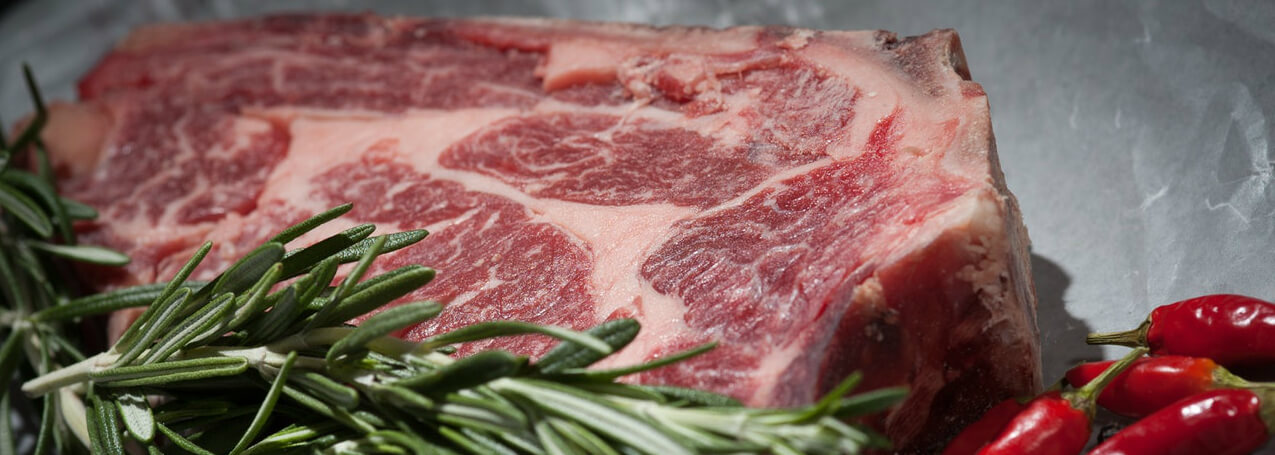
Dietary fat, particularly animal fat, has been demonized for a long time, so it’s not surprising that many people are cautious about increasing their fat intake on keto.
Fortunately, recent research has shown that while man-made fats such as vegetable shortening and margarine contain what are known as trans fats that can do harm, natural fats like butter and olive oil produce fatty acids like omega-3 and omega-six, which can protect you from heart disease and other issues.
Another enduring myth is that you “need” carbs for energy.
Remember your old coffee and pastry breakfast? Remember how after eating it you felt ready to take on the world? You should also remember the drop in energy after all the glucose was burned up, which of course gave you an excuse for another donut or a Snickers bar.
When you’re running on fat, those crashes will be a thing of the past as your energy stays at steady levels.
Calories, Macros and Net Carbs
Do calories matter on a keto diet?
A question that often comes up when discussing ketogenic diets is, “do calories matter?”
If you visit certain diet forums or social media sites, you’ll no doubt run into those who claim that they can eat a ton of calories and still lose weight, provided that their food matches their macro goals.
They talk about adding huge amounts of butter to their steak and unlimited cheese sauce to their veggies. Unfortunately, no diet works this way. Calories still do matter.
However, since fat and protein are so satiating, while sugar and refined carbohydrates are not, calorie restriction comes naturally when following a low carb diet.
It’s easy for most of us to quickly devour a pint of Ben & Jerry’s ice cream, which can have well over 1200 calories, but it would be hard for that same person to eat a fatty ribeye steak with the same caloric energy.
What are these "macros" of which you speak?
Macros is the collective term for fat, protein and carbohydrate grams.
A gram of fat contains nine calories, while protein and carbohydrates each have four calories per gram.
For example, a person following a standard ketogenic diet (70% fat, 25% protein, and 5% carbs) consuming 2000 calories per day would consume roughly 1400 calories or 155 grams of fat, 500 calories or 125 grams of protein, and 100 calories or 25 grams of carbohydrates.
But, there’s a little more to it than that. Keep reading…
Are all carbs the same? Net carbs and the keto diet.
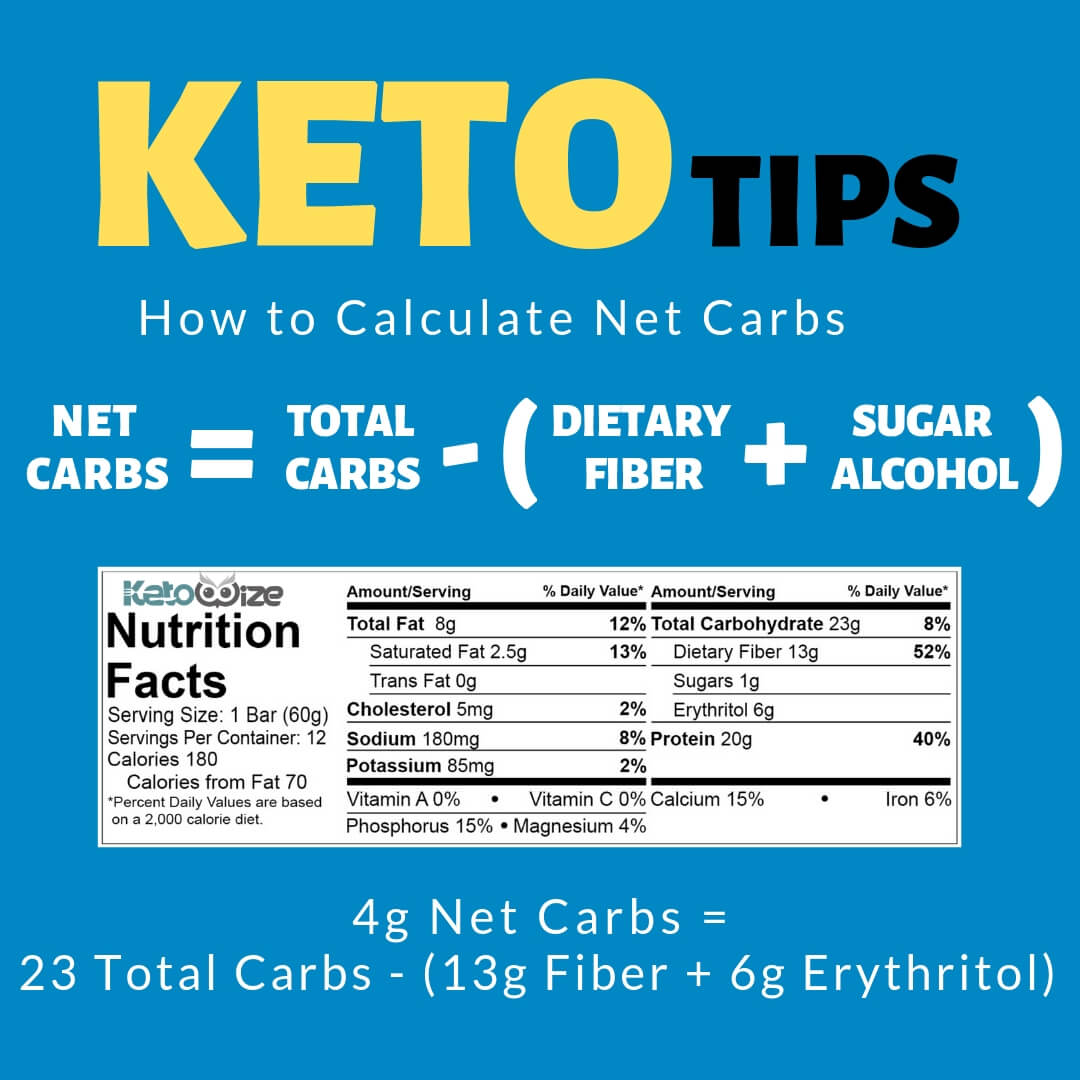
Not all carbs are created equal. Not even close.
Many carbs come with a little bonus – and that bonus is FIBER!
Fiber in foods is counted as carbs, but that fiber is not digested. It’s simply expelled as waste. And since we don’t digest it (read: use it for energy), we can subtract the fiber grams from the total carbs to get “net carbs.”
Here’s a little example if you’re new to this stuff.
A three-ounce bag of baby carrots has roughly 8 grams of carbs. But that same bag contains about 3 grams of fiber. When we subtract the fiber from the total carbs, we end up with 5 net carbs. This lets you enjoy a tasty snack while not blowing through your daily carb limit too quick.
Keto Food List: What To Eat (And What To Avoid)
We’ve talked about fats and ketones and macros, now let’s talk actual food!
If you’re uncertain about what (and what not) to eat on a low carb ketogenic diet, don’t you worry. Ketowize has you covered.
First, let’s talk about the foods you should avoid when going ketogenic.
Avoid These Foods When On A Keto Diet
- Grains (this includes corn, rice, etc.) - Any grain-based product should be avoided when on a ketogenic diet. While wheat and corn are the two biggest offenders in today's food supply, you'll also want to avoid "healthy" grains like quinoa, bulgar, oats, and bran.
- Breads and Pastas - These two foods make up the bulk of the Standard American Diet (SAD). It's no wonder we're the most obese we've ever been. If you're looking for keto alternatives to these favorites, check out some of our favorite keto recipes.
- Sugars - Avoid all types of sugar when going keto. This includes basic table sugar, corn syrup, high-fructose corn syrup, etc., as well as "healthy" sweeteners such as honey, agave, etc.
- Starchy Vegetables (like potatoes) - You'll want to avoid all starchy vegetables that grow in the ground like yams, sweet potatoes, and regular potatoes. For a list of vegetables to eat and which ones to avoid, check out our comprehensive low carb vegetable guide.
- Low Fat "Diet" Foods - Since sugar is usually used to replace fat to keep these foods tasting good, they are often higher in carbs than their full-fat counterparts.
- Processed Foods - Commercially produced proccessed foods like chips, cookies, cakes, muffins, and pretty much anything with a long shelf life contain a host of ingredients you can't pronounce and will significantly slow your weight loss progress.
- Soda/Pop - A simple rule to weight loss (no matter what the diet) is don't drink your calories. A can of soda has nearly 10 teaspoons of sugar (39 grams). Replace your soda with water, tea, or a carbonated water beverage like La Croix.
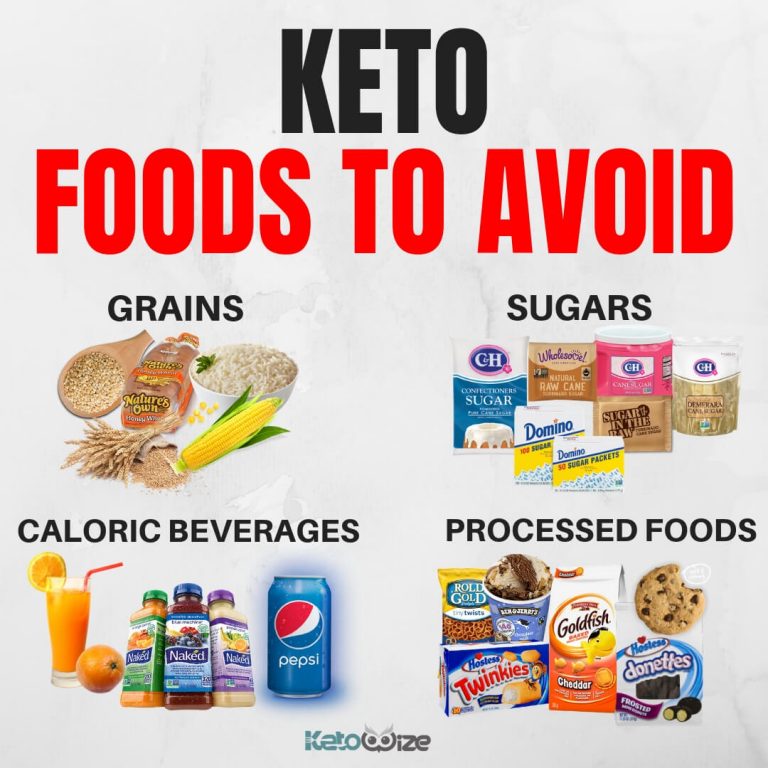
Now that we’ve gotten the bad stuff out of the way, let’s take a look at all the great stuff you can eat.
Foods With Super Low or No Carbs
- Red Meat (beef, pork, lamb) - You'll want to stick with fattier cuts (think ribeye steak) whenever possible. With pork, make sure to avoid any added sugars as they sometimes sneak them in here.
- Poultry - Feel free to enjoy chicken, duck, pheasant, quail, and other game birds, but always try to opt for the higher fat cuts like thighs and wings over breasts. Remember, the keto diet is a high fat diet not a high protein diet. Excess protein will be converted to glucose, so watch your macros.
- Eggs - Eggs contain very little carbohydrates (less than 1 gram per egg) and are a great keto friendly food.
- Fish and Seafood - Most all fish and seafood is great for keto dieters and is generally carb free. As for shellfish, shrimp and crab are great choices. Muscles and clams do contain a bit of carbs, but as long as you're not eating two pounds of clam meat, you should be okay.
- Hard Cheeses - Cheese is packed with flavor and super satiating. And, since most cheese is super low in carbs (often less than 1 gram per serving) and high in fat, it's one of the most perfect keto foods.
- Oils - Oils such as olive oil, MCT oil, and coconut oil are great for keto dieters. These oils are high in monounsaturated fats and antioxidants which are great for the heart. They've also been shown to increase ketone levels which may promote sustained levels of ketosis.
- Butter and Heavy Cream - Butter, ghee, and heavy cream are either very low or no carb foods. When consumed in moderation, they have been shown to have neutral or even beneficial effects on heart health.
- Natural No Carb Sweeteners - Erythritol and Stevia herb are two calorie (and carb) free sweeteners we love. Just like sugarcane or honey, these sweeteners are completely natural despite their chemical sounding names.
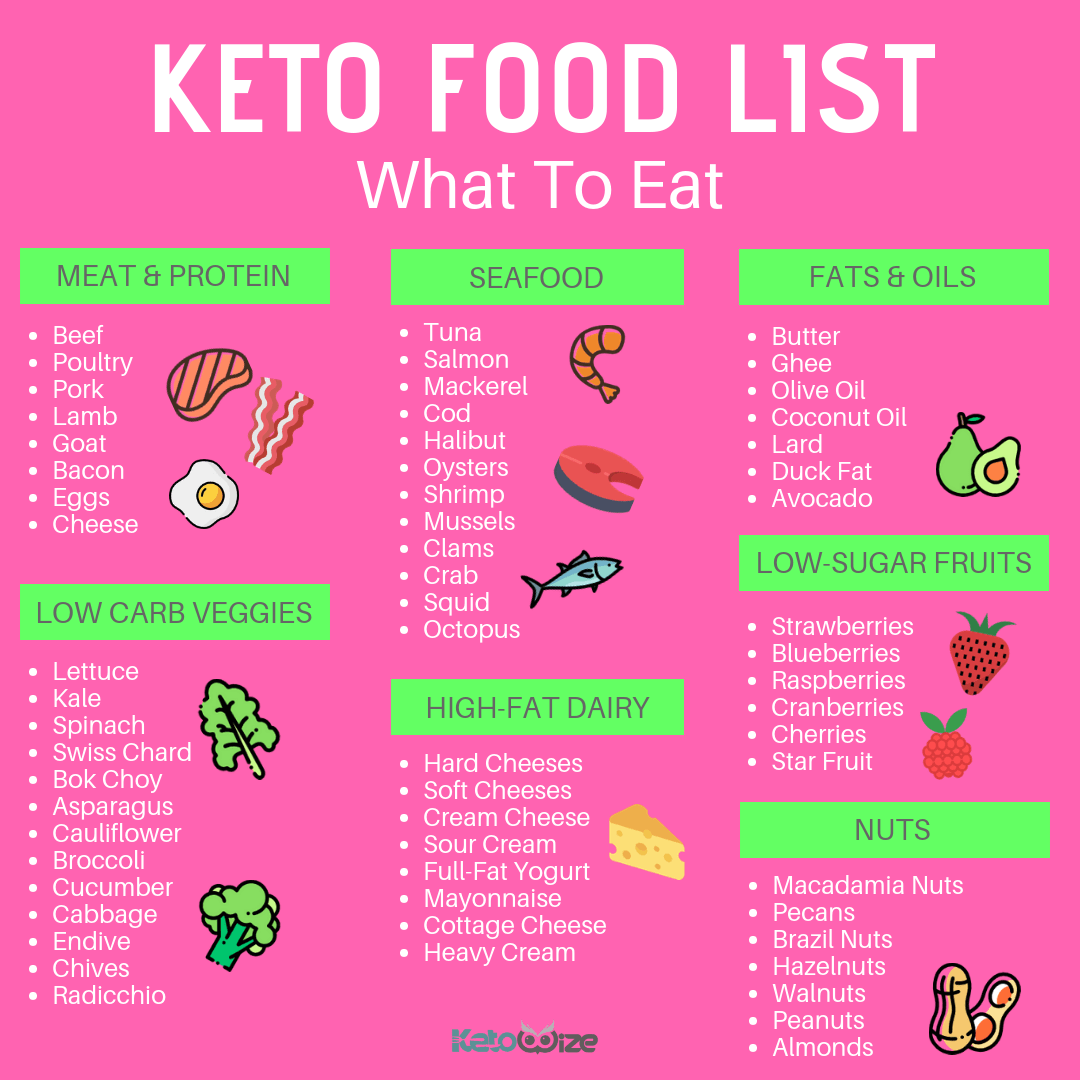
Low Carb Foods
- Above Ground Vegetables - Fresh veggies are a very important part of a low carb diet but it's important to choose non-starchy veggies which are lower in carbs. Take a look at our sortable keto vegetable list to find the ones with the lowest carbs
- Certain Fruits - Being keto does not mean you have to eliminate all fruit from your diet but you will want to choose fruits low in sugar. These include berries, such as strawberries, raspberries, and blackberries, avocados, starfruit, lemons, limes, and more.
- Full-Fat Dairy - Dairy can be a part of a successful ketogenic diet plan but always pick the full-fat variety. We love sour cream, cream cheese, heavy cream and butter!
- Nuts and Nut Butters - Nuts and nut butters are a keto dieters best friend. They are high in fiber and keep you full for hours. The high fiber means most of the carbs don't count.
It’s pretty hard to feel deprived when you can have bacon and eggs for breakfast, a chicken Caesar salad for lunch, a steak, buttered broccoli, and sauteed mushrooms for dinner, and berries with heavy whipping cream for a snack.
If you cook or want to try, we have lots of delicious low carb and keto recipes right here on the website.
Oh Shoot, Here Comes The Keto Flu
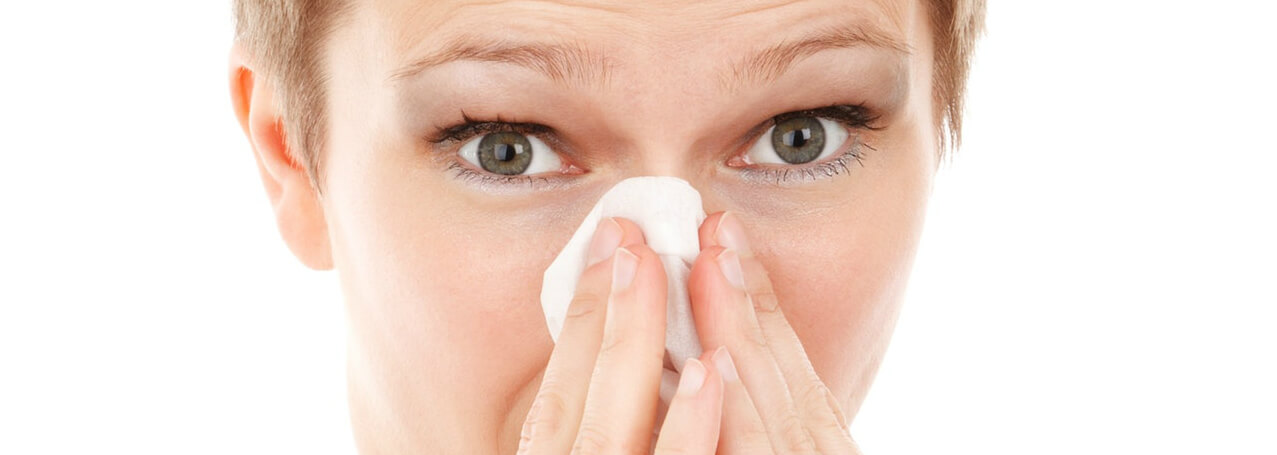
Most people find themselves feeling great when they start a ketogenic eating plan – energetic, clear headed, and light.
Others, though, find themselves feeling lousy.
Your body, which is used to using glucose for fuel, is now finding only fat, and it’s confused. As a result, new low carb dieters can experience what’s known as the dreaded keto flu.
Symptoms of the Keto Flu
The name “keto flu” came about because the symptoms feel an awful lot like the actual flu.
Headaches, fatigue, nausea, diarrhea, brain fog, muscle weakness, difficulty sleeping, and dizziness are classic symptoms of the keto flu. Oh, and let’s not forget the massive sugar and carb cravings.
Sometimes the symptoms are bad enough that people give in and eat carbs just to feel better. However, in a way, the keto flu is a good sign because it lets you know that you’re getting into ketosis and switching over to burning fat for fuel.
Relief from the Keto Flu
The keto flu definitely sucks but fortunately, it doesn’t last too long, and there are a lot of ways to relieve the symptoms without going face-first into a pile of carbs.
Exercise helps a lot but this is not the time to go crazy at Crossfit. Go for a nice walk with your significant other, a friend, or your dog and get your heart pumping but not pounding.
A lot of the symptoms are due to water and electrolyte loss, so drink a carb-free sports drink to raise your electrolytes. This is the one I drink, if you’re interested. Drink more water in general – eight glasses a day is a good goal, but you can always have more and enjoy the added benefit of feeling full.
Since you’ve cut out processed foods, your body’s also reacting to a lower sodium intake. Just like you need fat, you also need sodium, so make sure you add salt to your food and enjoy higher sodium snacks like pickles and hot sauce.
If you feel like you must up your carb intake, do so with fibrous vegetables and not snack cakes or Twinkies. The fiber will ease the transition into ketosis.
You will also want to make sure you are keeping your fat intake up. Many keto dieters swear by bone broth. This high fat broth will replenish electrolytes and sodium, in addition to being delicious and fitting your macros.
You can make your own using beef soup bones, chicken wings or leftover bones from roast chicken. Simply simmer them in water on your stovetop, in a slow cooker, or a pressure cooker. Those not handy in the kitchen can find bone broth in the supermarket or online.
Final Thoughts On The Keto Diet
It may seem like a lot but the keto diet is actually quite simple. Start by cutting your carbs down to about 25-30 grams per day and you’ll be burning fat for fuel in no time.
The Ketowize website has you covered for recipes, articles, keto essentials, and anything else you may need.
SOURCES
https://www.healthline.com/health-news/keto-diet-is-gaining-popularity-but-is-it-safe-121914#1
https://en.wikipedia.org/wiki/Framingham_Heart_Study
https://www.sevencountriesstudy.com/about-the-study/
https://www.health.harvard.edu/staying-healthy/the-truth-about-fats-bad-and-good
https://thebigfatsurprise.com/
https://www.healthline.com/health/ketosis-vs-ketoacidosis
https://www.health.harvard.edu/blog/intermittent-fasting-surprising-update-2018062914156
https://www.health.harvard.edu/staying-healthy/the-truth-about-fats-bad-and-good
https://healthyeating.sfgate.com/gram-protein-carbohydrates-contains-many-kilocalories-5978.html
